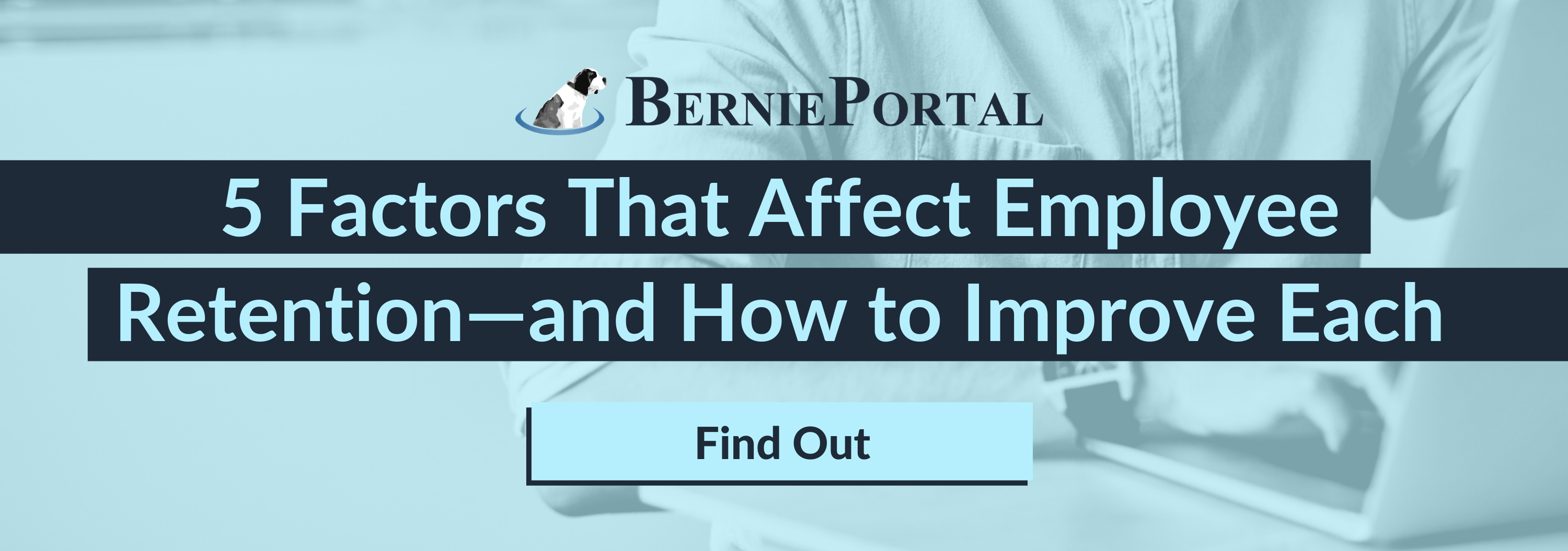Written by
Will Miranne
Will is an aPHR-certified writer on the marketing team at BerniePortal. He writes about healthcare, human resources, and benefits.
How Does Attrition Rate Impact Your Business?

Attrition rate is the loss of employees or customers who are ultimately not replaced. This differs from the turnover rate, which simply tracks lost employees or customers. A high attrition rate means that more employees are leaving than are being brought in, while a low attrition rate means that vacant roles are being promptly filled.
High employee turnover can ultimately lead to higher attrition rates as the more vacant roles there are, the more difficult it is to fill them all. This metric is often used to create new marketing campaigns, as well as track job vacancies.
Are High Attrition Rates Bad?
Though having a high attrition rate is not inherently bad, it is often deemed to be a determining factor in whether a company is performing well or not. This in part comes down to the basics of what attrition rate is.
If your organization is losing employees without replacement, then that can only mean there are issues internally. There is a reason employees are leaving, and a reason that job seekers are reluctant to join. To understand whether the rate is truly cause for concern, the attrition rate needs to be examined.
Turnover rates vary by industry. Compare the national average of 60.5% in the restaurant and wholesale industry, to the 11.8% in the energy industry. Most industries fall between 12% and 15%, but it ranges widely from top to bottom. Look at what your industry average is, and find successful ways in which you can hit your turnover goals. If turnover rates are high you are likely to see an increase in your attrition rate as well.
How to Combat High Attrition Rates
If you are looking to lower your turnover and attrition rates, the first step is to determine your underlying cause. From here it is a matter of building out a strategic plan to get your organization back on track. It may take time to determine the exact factors causing the turnover, however the first step is to move forward with a plan that matches your organization's needs.
Let's say that after looking at the data and surveying your employees, you have determined that most of your workers are looking to spend more time working from home. You are also aware that In your industry it has become increasingly common to have employees working from home. In this case, offering a hybrid working schedule would be a great way to begin lowering your attrition rates. You will both give your current employees a benefit that entices them to stay, while also increasing your chances of promptly filling open positions.
What Effect Do Attrition Rates Have on Businesses?
According to SHRM, businesses should be prepared for higher turnover rates when the pandemic finally ends. These high expected turnover rates can potentially lead to a rapid rise in attrition rates as well.
Losing employees inevitably puts work onto other employees who may already be at their limit. This will cause issues with delays and missing deadlines, in favor of hitting others. This in turn, could further affect company culture and employee satisfaction.
If an employee either leaves or is let go from an organization, said organization would then need to build a strategy in order to fill that role with the proper talent. If the role was deemed redundant, the strategy changes. It could be beneficial to move the job responsibilities to other departments or employees. This would cut down on costs and provide some monetary relief for an organization. That said it might also overburden other employees, now forced to pick up the slack.
In order to correct the problem it is crucial to understand the basis of the attrition rate. Is it high due to a specific reason? Is it a temporary matter merely needing a bit of time in order to correct? Perhaps you have several employees retire at once. It can take time to fill those roles. Though there are perfectly understandable reasons for an increased attrition rate, often there are underlying issues that need to be addressed. In doing this, you can work to increase employee retention.
What Are Common Causes for High Attrition Rates?
According to research commissioned by the Achievers Workforce Institute, 35% of turnover is due to better benefits and compensation, while 25% was due to better work/life balance. That said, the rise in attrition rate can have various underlying causes.
- Declining company culture
- Low employee satisfaction
- Lack of appeal
- Poor benefits packages
- Retirement
- Receive a promotion
- Relocation
- Resignation
- Personal reasons
A unique set of strategies will be required to combat each of these concerns. Knowing the heart of the problem is crucial to building the proper systems and recruitment strategies needed to stabilize rising attrition rates. Potential employees may wish to know the reason why the turnover seems high, in which case it is important to have strategies in place. These strategies should showcase your priority on keeping employees both happy and satisfied.
What are the Different Types of Employee Attrition?
According to Indeed there are several types of employee attrition to be mindful of.
- Voluntary attrition refers to an employee leaving a company of their own accord. This could be for numerous reasons such as resignation or promotion.
- Involuntary refers to the organization choosing to end the relationship with the employee. This could be due to layoffs, termination, an absolved position.
- External attrition refers to someone leaving the organization for a position with a different organization.
- Internal attrition refers to someone taking on a new role within the organization.
How To Calculate Attrition Rate
While most employers will use software to calculate this metric, it can be valuable to understand how the equation works. Typically the rates are calculated on a monthly, quarterly, or yearly basis. According to Indeed there is a 7 step process that you can use to calculate the rate:
- You will first begin with the number of employees at the start of the period, be it monthly, quarterly, or yearly.
- From here, determine the number of employees who left during that same period.
- Next, find out how many employees were hired during that same period.
- Subtract the number of employees who left from the starting total number of employees, and then add in the number of new hires, to determine the ending number.
- Now find the average by adding the starting and ending numbers and dividing the number by two.
- Take the number of employees who left by the employee average to determine the decimal rate of attrition.
- Multiply that number by 100 to see the attrition rate as a percentage.
An example would be:
It is time for the human resources department at Johns Trucking Company to analyze their attrition rate. They started the year with 50 employees. Throughout the year, 10 left the company, and 4 were hired on. We can now use the formula to determine the annual attrition rate.
50 - 10 = 40
40 + 4 = 44
50 + 44 = 94
94 / 2 = 47
10 / 47 = 0.212
*0.212 x 100 = 21.28%*
Understanding what goes into determining an organization's attrition rate can help you to organize a proper strategy quickly and efficiently. If you feel that your attrition rate might be high, analyze the data, and seek out a solution that will effectively lower your rate and get your business back on track.
Written by
Will Miranne
Will is an aPHR-certified writer on the marketing team at BerniePortal. He writes about healthcare, human resources, and benefits.
Related Posts
We just wrapped up another phenomenal Weekdays with Bernie (WWB) Conference!
Employees are the heart and soul of an organization, and valuing their opinions can have...
HR parties of one already have an abundance of tasks to keep up with. From hiring to...
The talent search is no longer a skirmish or a battle. It’s a WAR! As a strategic HR...







Submit a Comment